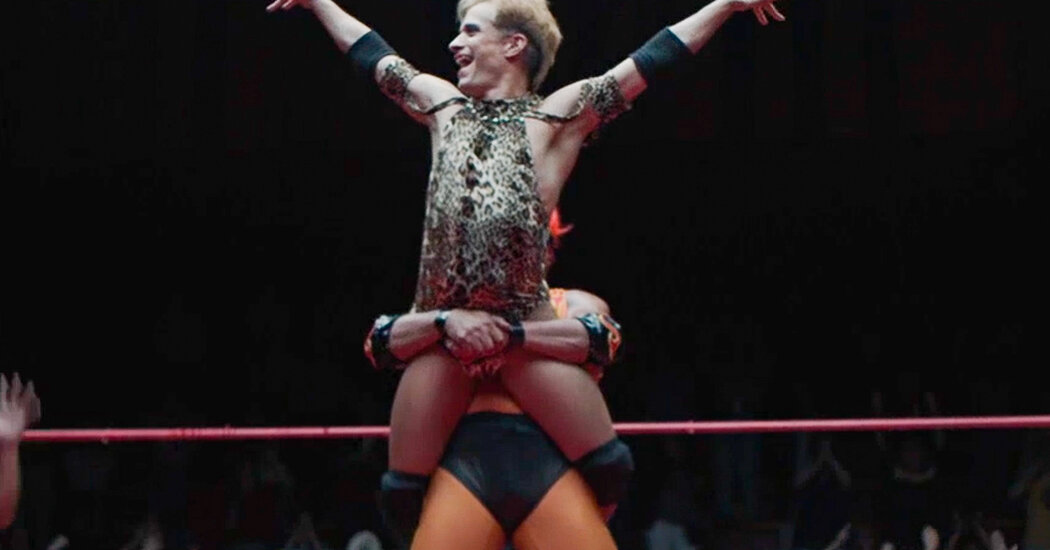
He strides into the ring in a long, sequined cape. His shimmering bodysuit, platinum blond hair, exaggerated eye makeup and the pop of red on the lips easily set him apart from his snarling opponent, who wears his masculinity like armor. He is Cassandro, the Liberace of Lucha Libre.
In a new biopic set in the world of Mexican masked wrestling, Gael García Bernal plays Saúl Armendáriz, a real-life exótico — as drag-inspired stars of lucha libre are called — who captured the imaginations of audiences as the fabulous Cassandro. A gay man in a culture that rewards machismo, he defied expectations by pairing a flamboyant style with hard-hitting body slams.
Directed by the Academy Award winner Roger Ross Williams, the film, which was released this week on Prime Video, follows Cassandro’s transformation from amateur wrestler to ultrafeminine fighter.
The film’s costume designer, Mariestela Fernández, spoke about the creative challenge of navigating both sweat and glitter in the wrestling ring. Ms. Fernández’s remarks have been lightly edited and condensed.
How familiar were you with lucha libre culture and Cassandro before you started working on the movie?
Well, being Mexican, that is part of our culture, and it’s been very important since the 1970s. In terms of costumes, this aesthetic around lucha libre is a phenomenon.
I knew about the exótico luchadores, but I did not know how important Cassandro is. Before Cassandro, all the lucha libre exótico fighters would lose. But after him, that all changed. You can be a great luchador, and it depends on you and on how you can fight — no matter what you look like. I think that is the heart of the story.
What does it mean to be an exótico? Is there a signature look or style?
I would say it’s sort of like drag in lucha, to put it in a very simple way. It’s being able to dress as a woman or in drag and also be a luchador. But the concept was that you would be made fun of: You are a homosexual, you dress like a woman, you’re not man enough. This is a very macho environment we’re talking about. No matter if you’re good, they will make fun of you and you will always be the comedic part of lucha, but never the outstanding athlete.
So that’s what’s important with Cassandro. Apart from being called the Liberace of the Lucha Libre because of his amazing and glossy and bright and shiny outfits, he was and is a great luchador.
How is it different designing a costume that has to withstand so much physical activity?
The actor has to be very comfortable and be able to do all the tricks and all the lucha. But then again, with Cassandro in mind, it had to be a whole statement with fashion. Apart from being a great luchador, he was a great designer, too.
I had to do a lot of research because I wanted to sort of grab what Cassandro used to wear and make it really cinematic, so it was a little bit stylized. The rest of the luchadores had to be designed from scratch since we didn’t have the rights except for El Hijo del Santo [a lucha celebrity and Mexican folk hero]. I didn’t do it on my own. It was a whole group of people who did these outfits.
What are some of your favorite outfits from this film?
I appreciate the first look he wears. It’s an outfit he designed from his mom’s dress. His mom was really loud and used a lot of prints. Although it’s not that glamorous, I love the way he pulls out some blouses and skirts that he’s seen on his mom and puts it all together. And that’s the way Cassandro is born.
And then of course, I love the red one. I mean, it’s beautiful with gold. And it’s so important for him when he fights in Mexico City; it’s like the shrine for all luchadores from all over the country. And Cassandro is not from Mexico City — he’s from the border of Juárez and El Paso.
When working on this film, did you have a specific color palette in mind when designing Cassandro’s looks?
Yes, I wanted to have references to the Mexican flag with outfits that are green, more into white and silver, and some that are red.
There’s also another part where he’s honoring his American upbringing in El Paso. So there are also blue, red and white outfits. It was very important for me to show both sides of the border, even though these colors and these outfits were not necessarily something he wore in real life.
And then of course, there’s pink, because it’s associated with the exóticos and being girlie.
What was it like designing the luchador masks?
It’s like this whole persona that you’re doing. I believe the mask is the most important way of understanding lucha. The mask is something that you put on and then you disappear. It’s like in theater: The mask is really where the character sits, lives and breathes.






